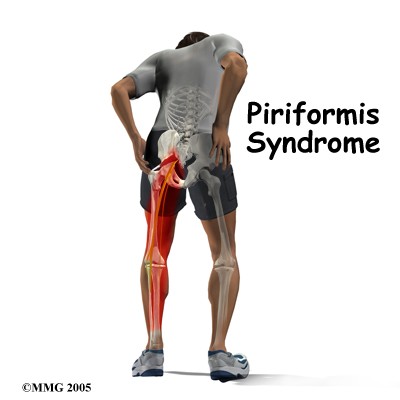
Introduction
This is a neuromuscular disorder that occurs when the sciatic nerve is compressed or otherwise irritated by the piriformis muscle causing pain, tingling and numbness in the buttocks and along the path of the sciatic nerve descending down the lower thigh and into the leg.

In 15-30% of the population the sciatic nerve passes through the piriformis muscle rather than underneath it. These people have been reported by some studies to have a greater incidence of piriformis syndrome than does the general population.

Runners, bicyclists and other athletes engaging in forward-moving activities are particularly susceptible to developing piriformis syndrome if they do not engage in lateral stretching and strengthening exercises.
Diagnosis
Patients complain of pain exacerbated with activity, prolonged sitting, or walking. This is typical sciatic pain, tingling and numbness in the buttocks and along the path of the sciatic nerve. The pain may be relieved by walking with the foot on the involved side pointing outward, externally rotating the hip, lessening the stretch on the piriformis. There may be tenderness in the area of the sciatic notch. Provocation test attempt to stretch the irritated piriformis and cause sciatic nerve compression (Freiberg test, Pace test, and the FAIR - "Flexion, Adduction, Internal Rotation" maneuver).
Confirming the syndrome is often difficult due to few validated and standardized diagnostic tests, therefore this is a diagnosis of exclusion - once the common causes of sciatic compression have been excluded (i.e. MRI spine for root entrapment). Ultrasound guided injection may help identify the site of nerve irritation.
Treatment
Symptomatic treatment with non-steroidal anti-inflammatory drugs is often helpful. Conservative treatment usually begins with stretching exercises and massage, and avoiding precipitating activities, such as running, bicycling, rowing, etc. Some clinicians recommend formal stretching techniques, massage, and strengthening of the core muscles to reduce strain on the piriformis. Stretching exercises target the piriformis, but may also include the hamstrings and hip muscles. Ice can be helpful when the pain starts, or immediately after an activity that causes pain. Gait correction can reduce the use of the piriformis, allowing the inflammation heal. Custom foot orthotics also help with both treatment and preventing recurrence.
If the conservative treatments described above fail there are various injections that can be used (e.g., lignocaine, anti-inflammatory drugs, corticosteroids). Botulinum toxin has been used which inactivates the piriformis muscle for 3 to 6 months, causing minimal leg weakness or impaired activity. Injection is done with image control (high-frequency ultrasound or CT).
Rarely surgery may be recommended to explore and decompress the nerve.
© Mr Gavin Holt :: CotswoldClinics.com :: Print this frame